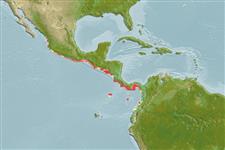>
Ophidiiformes (Cusk eels) >
Dinematichthyidae (Viviparous brotula)
Etymology: Ogilbia: Taken from Ogilby, 1887-1915, icthiologist and zoologist (Ref. 45335); robertsoni: Named for Dr. D. Ross Robertson, Smithsonian Tropical Research Institute, Panama (STRI).
Eponymy: James Douglas Ogilby (1853–1925) was an Irish-born Australian ichthyologist and taxonomist, son of the famous zoologist William Ogilby (below). [...] Dr David Ross Robertson (d: 1946) is an ichthyologist whose bachelor’s degree (1966) and doctorate (1974) were awarded by The University of Queensland, Australia. [...] (Ref. 128868), visit book page.
More on authors: Møller, Schwarzhans & Nielsen.
Environment: milieu / climate zone / depth range / distribution range
Ecología
marino demersal; rango de profundidad 6 - 27 m (Ref. 57883). Tropical
Eastern Pacific: Mexico to Costa Rica.
Tamaño / Peso / Age
Maturity: Lm ? range ? - ? cm
Max length : 7.1 cm SL macho / no sexado; (Ref. 57883)
Short description
Claves de identificación | Morfología | Morfometría
Radios blandos dorsales (total) : 67 - 77; Radios blandos anales: 51 - 57; Vértebra: 39 - 41. This species is distinguished by the following characters: Vertebrae 11 + 28-30 = 39-41, dorsal fin rays 67-77, anal fin rays 51-57, outer pseudoclasper with a single, long supporter, extruding into spine-like tip; inner pseudoclasper is slender with a long, straight supporter, almost length of supporter of outer pseudoclasper with ligamentous connection to outer pseudoclasper
anteriorly; penis tapering; opercular spine with single sharp tip; scale patch on cheeks with 6-9 vertical scale rows; otolith length: height ratio 2.2-2.3 (Ref. 57883).
Habitat not known; no ripe females were observed (Ref. 57883).
Life cycle and mating behavior
Madurez | Reproducción | Puesta | Huevos | Fecundidad | Larva
Møller, P.R., W. Schwarzhans and J.G. Nielsen, 2005. Review of the American Dinematichthyini (Teleostei: Bythitidae). Part II. Ogilbia. aqua, J. Ichthyol. Aquat. Biol. 10(4):133-207. (Ref. 57883)
IUCN Red List Status (Ref. 130435: Version 2024-1)
Threat to humans
Harmless
Human uses
Herramientas
Special reports
Download XML
Fuentes de Internet
Estimates based on models
Preferred temperature (Ref.
123201): 26.8 - 29.1, mean 28.3 °C (based on 118 cells).
Phylogenetic diversity index (Ref.
82804): PD
50 = 0.5000 [Uniqueness, from 0.5 = low to 2.0 = high].
Bayesian length-weight: a=0.00389 (0.00180 - 0.00842), b=3.12 (2.94 - 3.30), in cm total length, based on all LWR estimates for this body shape (Ref.
93245).
Nivel trófico (Ref.
69278): 3.3 ±0.5 se; based on size and trophs of closest relatives
Fishing Vulnerability (Ref.
59153): Low vulnerability (10 of 100).
